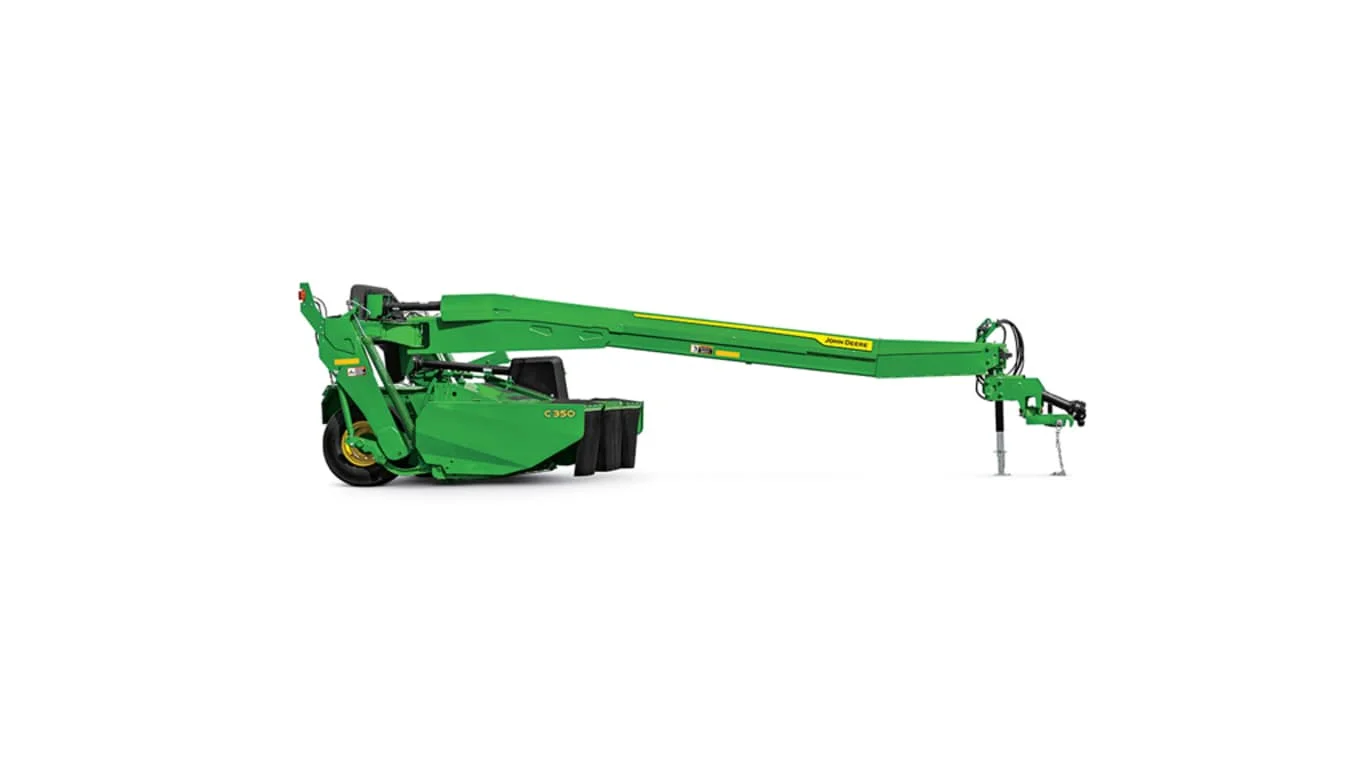
- Updated design and styling
- Impeller, urethane or V-10 conditioners
- Forming vanes provide the option of wider windrows
- Easier serviceability with modular-design cutterbar
Features
Protect your crop with conditioner options to fit your needs
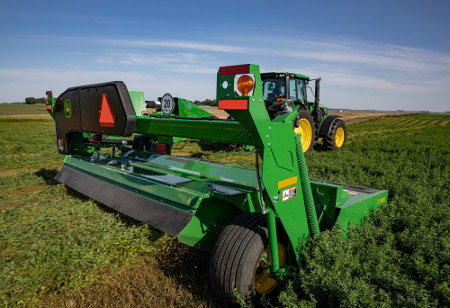 C400 Mower-Conditioner
C400 Mower-ConditionerAchieving the right conditioning action can significantly reduce dry down time. That means less time needed to cure, maintaining optimum feed values, and preventing leaf loss in legumes. Hay and forage producers have a wide variety of crops and conditions. That’s why John Deere mower-conditioners offer four different conditioners.
- Conditioning reduces the time required for dry down
- Multiple conditioner options match a wide variety of crop types
- Faster dry down can increase nutrients retained in harvested crops
- Suitable for traditional dry hay or haylage operations
Conditioner types include:
- Impeller – ideal for light-stemmed grasses and alfalfa that respond well to scuffing of the stems
- Urethane – a soft roll that provides excellent performance in legumes and grasses
- V10 steel – increased crimping for faster dry down and improved wear life
- Tri-Lobe™ conditioner – a premium, patented roll system that uses a chevron design to crimp and crush
Reduced maintenance and proven cutterbar reliability with 5-year coverage
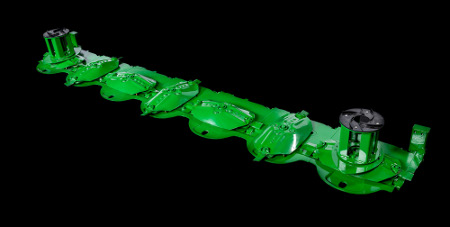 John Deere cutterbar with individual modules
John Deere cutterbar with individual modulesJohn Deere's patented design cutterbar is made from individual, diagonal-cut modules, making serviceability easy. Each module can be removed for service individually, leaving the remaining cutterbar modules attached to the frame.
- Nodular iron modules are highly resistant to impact damage
- Large, heavy-duty idler gears reduce driveline speed and wear
- Shear hub protection minimizes cost and decreases repair time in the field
- Gauge shoes provide accurate control of cut height and protect cutterbar
- Low-profile cutterbar allows the operator to cut at a flatter angle for improved cut quality and reduced wear on components
- Common oil bath keeps internal components lubricated and reduce oil-level checkpoints
Because John Deere is confident in the reliability, every mower conditioner includes a 5-year warranty on cutterbar components. This gives you peace of mind knowing that if you do experience a warrantable failure, your machine is backed through your experienced, local John Deere dealer.
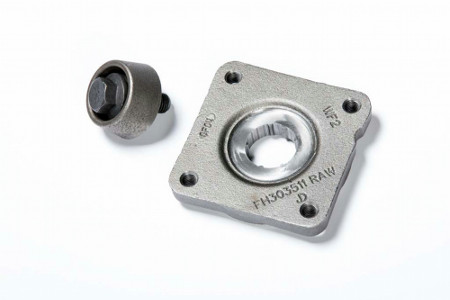 Shear hub
Shear hubEach cutting disk is attached to a shearhub (driver) on the splined pinion gear. Power to the disk is interrupted when the driver shears to protect the internal components of the cutterbar. Damage is limited to exposed components and does not require disassembly of the cutting modules.
- Reduces damage to the cutterbar and driveline components
- Improved uptime with limited disassembly required
 Gauge shoe
Gauge shoeThe gauge shoe setting determines the height of the crop stubble, but also prevents the majority of the cutterbar from being in constant contact with abrasive soils and rocks. The S250, S300, S350, C300, C350, and C400 have three height adjustments on the gauge shoe. The C450 and C500 come from the factory with six adjustments. Through service attachments, gauge shoe extensions are available to increase the number of adjustments if there is a need for higher stubble height.
Quickly prepare the mower-conditioner for transport
Overview
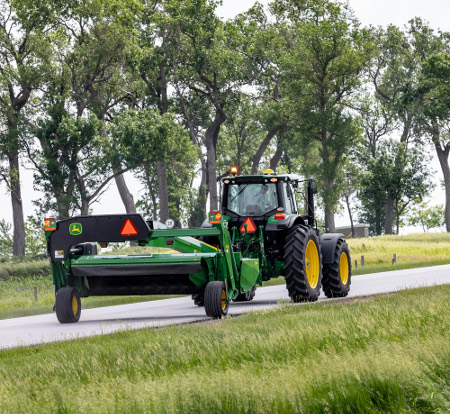 C400 in transport
C400 in transportAn advantage John Deere has over most competitors is that the mower-conditioners will transport directly behind the tractor at the same width as its cut. Operators can transition from road to field configuration and back again quickly and easily.
- Quickly move between fields when road transport is required
- Minimize transport dimensions for improved narrow road transport
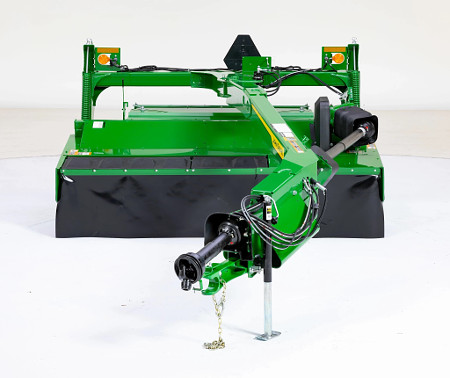 Side-pull model in transport position
Side-pull model in transport positionSide-pull models (S250, S300, and S350) have the tongue positioned in the center of the frame and drivelines that enter from the top to improve transport width.
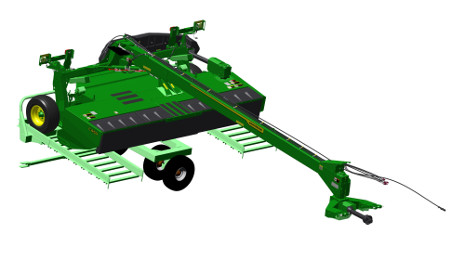
The C450 also has provisions to allow end-wise transport if you already have a dedicated transport cart. After backing the machine onto the cart and securing it, the tongue can be positioned parallel with the cutting head, allowing it to be towed by the tractor at under 2.8 m (9.2 ft).
Minimize dry down time with proper windrow formation
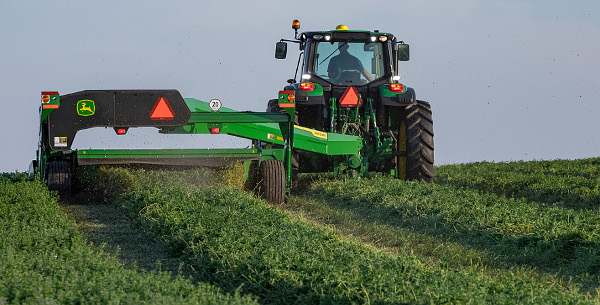 C400 windrow formation
C400 windrow formationWindrow formation is the final step of mower-conditioner functionality. Proper windrow formation is critical to reducing dry down times for dry hay and haylage or providing consistent chopping speeds and cut lengths for forage harvesting applications.
Characteristics of a quality windrow include:
- Consistent volume of crop throughout the windrow
- No clumping of material that can lead to inconsistent dry down
- Square shoulder and even edges
Sized to the width of the harvesting equipment or spread wide to allow for maximum exposure
John Deere mower-conditioners allow you to customize windrows to match your needs.
- Crop quality is maintained for higher feed value.
- Windrow width can be matched to harvesting equipment.
- Spread crop wide to maximize exposure (up to 337.8 cm [133 in.] with a properly equipped C400), further reducing dry down times.
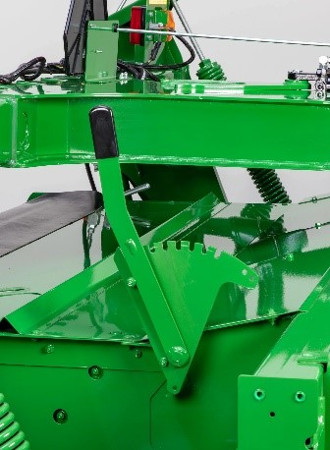 S models - swath board adjustment
S models - swath board adjustment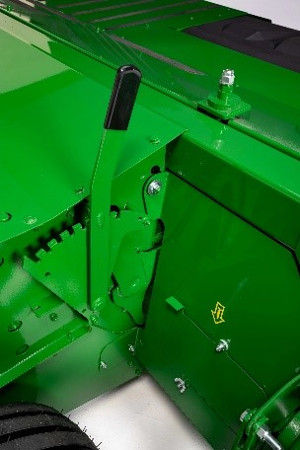 C models - swath board adjustment
C models - swath board adjustmentAdjustable swath boards help direct crop coming through the conditioner assembly, providing a quick adjustment to windrow width.
- No tools required for easy in-field adjustments
- Used to make large adjustments to windrow width
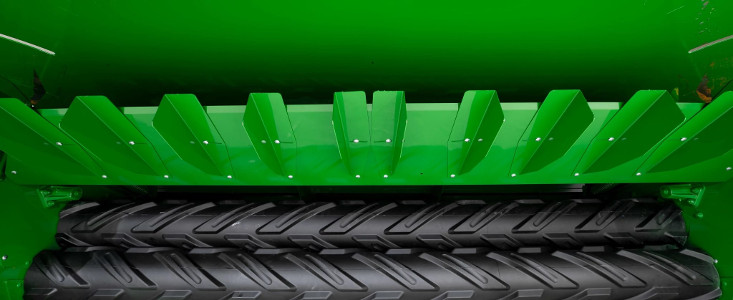 Forming vanes mounted to swath board
Forming vanes mounted to swath board0 Series Mower-Conditioners come standard with forming vanes on the swath board when available. Previously referred to as a wide swath kit, the forming vanes allow the mower-conditioner to increase windrow widths up to 25 percent and can be used to further customize windrow formation to match crop conditions.
- Install all vanes directing crop flow outward to provide the widest windrow and fastest curing
- Use vanes to direct heavy crop flow for more even distribution and consistent drying
- When not in use, forming vanes can be stored on the machine for easy access
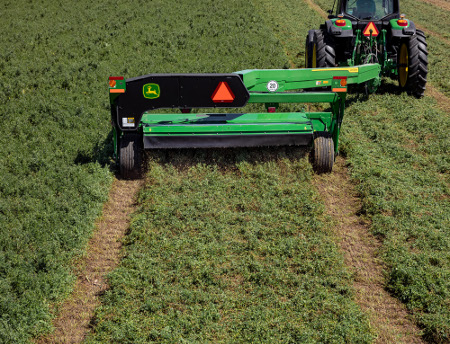 C400 wide windrow
C400 wide windrowThe C400 produced the widest windrow when tested against a competitive machine, providing a windrow of conditioned alfalfa that was over 337.8 cm (133 in.). This was over 84 percent of the cut width for the C400 compared to 72 percent for the competition.
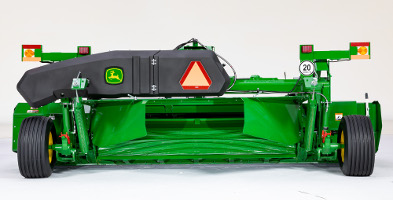 C500 narrow forming shield position
C500 narrow forming shield position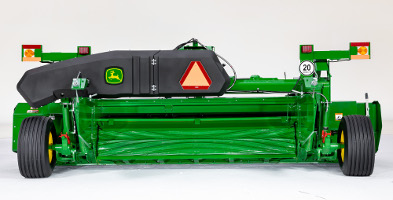 C500 wide forming shield position
C500 wide forming shield positionForming shields allow fine-tuning of the windrow width. This can allow you to easily match the windrow to your tractor’s tire spacing and prevent driving on cut and conditioned crop.
- No tools required for easy in-field adjustments
- Allow the operator to fine-tune the windrow width to match equipment and dry-down needs
- Operator can easily set windrow width as required because of changes in crop type, conditions, and operating speed


